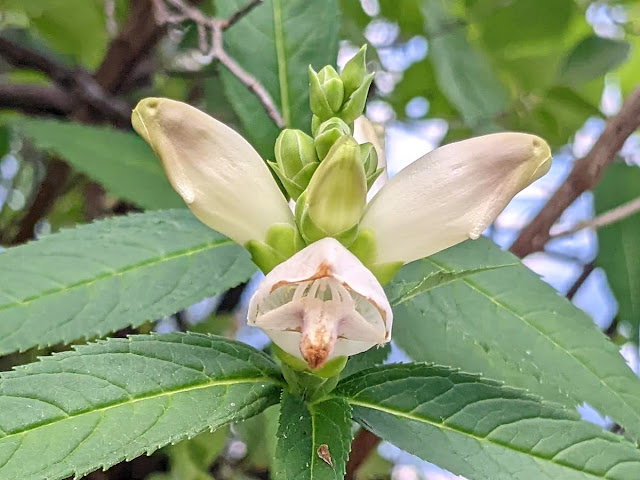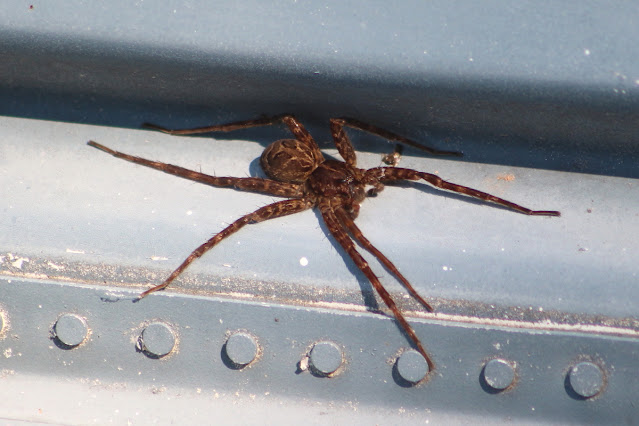As we move deeper into fall the colors of the Lakes Region start to change. Leaves are still predominantly green though more and more hints of yellow and red appear as the leaves slowly lose their chlorophyll-based green pigment. Most of the summer flowers have faded - though a few stubborn black-eyed Susans soldier on - but the fall flowers now get their moment in the spotlight. One of the most recognizable late-summer, early-fall flower is the turtlehead which grows in wet areas and is often found at the edge of the lake or other wetlands. It gets its name because the bloom resembles the head of a turtle.
 |
| Turtleheads (Chelone glabra) growing along the shoreline. |
The petals never really open up wide, forming an enclosed blossom with a small hole at the end.
 |
| All the good parts of the flower are inside the blossom. |
Turtlehead is an excellent filter for water runoff and holds soil well so it prevents erosion - it's an ideal species to plant along the water's edge, by retention pools, wet areas prone to erosion, and on borders of rain gardens.
Each turtlehead flower contains both the male and female parts needed to reproduce, but it requires a pollinator to move the pollen between the parts inside the flower. Similar to the Lady's slipper, the enclosed flower forces insects in search of nectar to climb inside the blossom where it rubs against the various sex parts of the plant, spreading pollen to the required areas to make seeds. It's a brilliant adaptation, and while looking at some of these plants I witnessed the pollination process in action. A bumblebee (the most most common pollinator of turtleheads because large, fuzzy bumblebees can survive colder fall temperatures) flew down to sample a flower.
 |
| Bumblebee on the approach path. |
I watched it land and climb inside the blossom.
 |
| In we go. |
It completely disappeared in side for perhaps a minute while it was collecting all the pollen it could find before climbing out and buzzing away.
 |
| Doing its thing in there. |
There'll be more turtleheads next year! It's a symbiotic relationship: The bumblebee gets food and the turtlehead gets to propagate its genes. Life on planet earth is dependent on pollinators in so many ways.
Autumn is also the time for asters, of many varieties and I don't know what they all are called. Some are very tall, four or five feet in height.
 |
| This wild calico aster planted itself by the house and now towers over Linda's day lilies. |
I think this one is a calico aster. Colors range from white to yellow to lavender, sometimes with a reddish hue.
The pearly everlasting doesn't look like the typical aster, but it's also in the aster family.
 |
| Pearly-everlasting (Anaphalis margaritacea) |
This plant spreads well and the flowers last for several weeks.
 |
| This patch expands its footprint every year. |
One of my favorite little flowers that pops up this time of year isn't an aster. Like the lady's slipper, it's in the orchid family and like so many flowers this one is also pollinated by bees.
 |
| Nodding Ladies' Tresses |
This is also a great time to enjoy the bright colors of goldenrod though I didn't come across much in my travels this week. But if you're in a field and see brilliant waves of yellow, look closely at the flowers to see what's pollinating them. And remember, goldenrod isn't actually a cause of allergies - it's usually the ragweed that often accompanies the goldenrod. You can read why goldenrod gets an unwarranted reputation in this article from the UNH Extension Service.
 |
| Small unknown beetles collecting pollen from goldenrod. |
On a whim I went to see if I could identify these beetles and sure enough, they are well known beetles on goldenrod and are called, appropriately enough, Shiny Flower Beetles. Something to look into on another day.
































